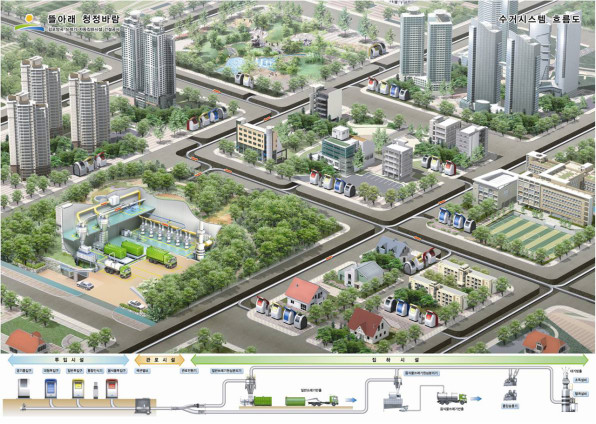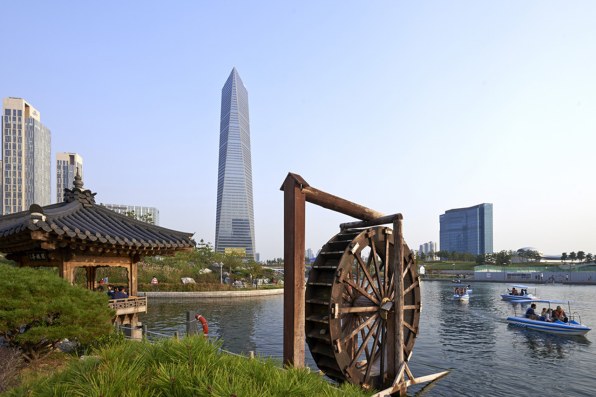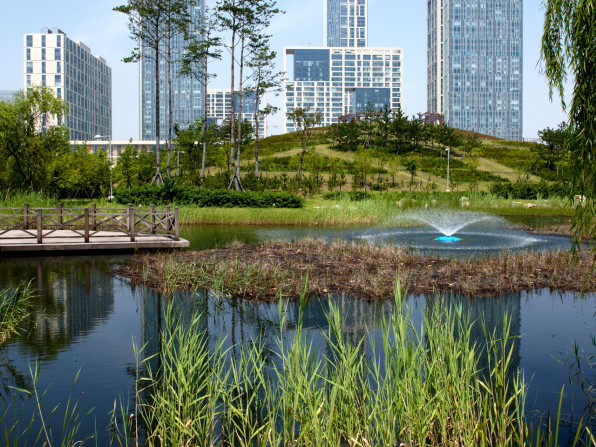Inside Songdo, The City Designed From Scratch To Be Sustainable
Can this Korean development outside of Seoul be the standard for how we build new cities in the future?
There aren’t any garbage trucks in Songdo, South Korea. Instead, trash is sucked through pneumatic pipes to a central sorting facility–in seconds–where it’s either recycled or turned into energy. Without a fleet of diesel trucks on neighborhood streets, Songdo has a lower carbon footprint.
It’s one of several ways that the area–a massive new development about the size of downtown Boston, built from scratch over the last several years–was designed to be more sustainable than a typical city like nearby Seoul. Compared to a city the same size, Songdo emits a third less greenhouse gases.

“Our vision from a design-build standpoint was, let’s start with the expectation of sustainability and efficiency,” says Tom Murcott, executive vice president of Gale International, the developer that led the master planning of the $35 billion urban development, built on reclaimed land along the Yellow Sea.
The whole area was designed so people might never have to drive. “A big goal of ours was to get people out of cars,” Murcott says. In a study, the team found that if people had to walk more than 12 minutes to a destination, they drive. So the developers put public transit stops within 12 minutes of every apartment building or business. Everyday errands can be accomplished on foot.
“You can pretty much walk to whatever you need, be it the supermarket, the dry cleaner, whatever it might be,” he says. Fifteen miles of bike paths loop through the district, connecting to another 91-mile network nearby. There are bike racks on every block. A 101-acre park–inspired by Central Park in Manhattan–stretches through the middle of the district, designed to make people want to walk. Forty percent of the area is green space.

For those who do drive, the development offers car sharing and gives priority parking to electric cars. Parking is underground, so cars don’t add to the urban heat island effect in the summer, and so there’s more space for pedestrians at street level.
The district holds 118 LEED-certified buildings; the entire development is also aiming for LEED certification at a neighborhood scale. The area is designed to use 40% less energy than a similar city. Everything is also wired to give feedback to residents, so someone can see how their heating or air conditioning or electricity use compares to the average for their neighbors.
“You’re using this technology to empower people living in the buildings to make good decisions,” says Murcott. (It’s not clear how effectively the system changes behavior; the utility companies haven’t shared their data with the developers.)
By 2020, the city plans to recycle 40% of the water used; effluent from buildings is used for flushing toilets and street cleaning. Stormwater is captured on green roofs and also used to irrigate parks.

Unlike some other notable attempts at building new eco cities–like Masdar City, which still has a tiny population–Songdo already has tens of thousands of residents in high-rises and tens of thousands more who commute to work in offices in the area.
That’s partly because there were already so many people living nearby. When the development created reclaimed land, that space was needed. “If you were to draw a 100-kilometer circle around downtown Seoul, 25 million people live in that circle,” says Murcott. “It’s very densely populated . . . we’re right in that circle. We were able to plug into a very thriving, vibrant, dense city.”
The area is still under construction; the development should be complete in 2020. In the meantime, the developers want to build similar cities elsewhere. In an early interview, they talked about building 20 Songdos, but they haven’t moved quite that fast. A project in China, called Meixi Lake, will be next.
As new cities follow the same pattern, planning gets faster. The master plan for Songdo took three years; Meixi Lake took six months to plan. “We’re constantly looking at other developments around the world that we can apply to this now,” says Murcott.

No comments:
Post a Comment